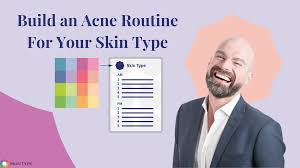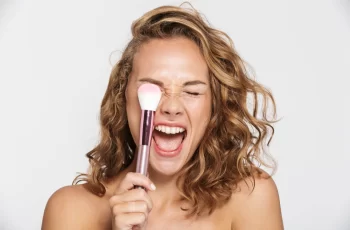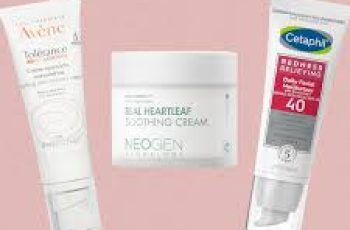
Build an Acne Skin Care Routine For Your Skin Type
The Best Custom Acne Skin Care Routine
To find the best acne products, you first need to know your skin type. You may have dark spots after a pimple clears, acne scabs or other skin issues that your personalized acne skincare routine should address.
Eight of the 16 Baumann Skin Types have acne and each skin type needs a different acne skin care routine. I will share with you my skin care routine advice for acne prone skin that I use for my patients. This blog will discuss how to build a regimens for oily, dry and sensitive skin with acne and for hormonal acne and cystic acne.
Take the acne skin care routine quiz so I can give you a dermatologist-recommended skin care routine for acne-prone skin that is custom for you.
The best part is –
After you take the quiz- we give you a list of good products and You get to pick the skin care brands to use in your acne skin care routine!
For every skin care routine step, you can choose acne skin care products from many brands. These products are chosen for you with a complex dermatologist-developed algorithm based on how you answer the quiz questions and what your skin type is.
You get to further customize the regimen based on your favorite skin care brands, your preferences and budget. If you want natural products or are vegan; if you want clean beauty products or recyclable packaging; or you think medical grade skin care products are best for acne- we have a custom acne skin care routine for you!
Our guidance will help you build the best custom acne skin care routine for your unique needs.
Skin Care Routine for Cystic Acne
Cystic acne is harder to treat than regular acne because the acne develops deep inside the hair follicle and it can be hard for skin care products to penetrate that deep into the skin.
This is why dermatologists usually treat cystic acne with an acne medication pill such as a:
retinoid like Accutane
antibiotic like doxycycline
hormone blocking pill like spironolactone
If you choose to use one of those acne pills, your skin type will change once you begin so do not buy any skin care products until you know how oily or dry you will be on the acne medication. Accutane and spironolactone can change oily skin types to dry skin types.
If you decide to try an acne skin care routine before you try oral acne medications, here is a skin care routine for cystic acne when you are not on a pill for acne.
Isotretinoin (accutane)
Skin Care Routine for Cystic Acne
Step 1 in AM- Wash your face using a low pH cleanser
A low pH cleanser helps loosen skin cells so acne medications can get in the skin. It lowers the skin pH so it is less attractive to acne causing bacteria, and it helps loosen dirt and debris from clogged pores.
Unless you have dry skin, a salicylic acid cleanser is the best to use to wash your face in the morning cystic acne skin care routine. It may be too strong to use twice a day so we recommend using a different cleanser at night if your skin gets easily irritated and sensitive.
Step 2 in AM- Apply eye cream
An eye cream is optional and protects the thin eye skin from any acne treatments that come next in the routine.
Step 3 in AM- Apply acne treatment product
There are many types of acne treatment products that you can use in step 3 of your morning regimen. These are choices you have, but only choose one of these from the list:
Acne medication from your doctor (not tretinoin)
Hydroxyacid peel pads
Hydroxyacid toner
Benzoyl peroxide gel
Apply ¼ teaspoon of gel or cream to the entre face or use the pads as directed.
Types of Acne Treatments for Step 3
PCA Skin Acne Cream
$45.00
Add to Cart
Replenix BP Acne Gel 10% Spot Treatment
$32.00
Add to Cart
Jan Marini Benzyol Peroxide Acne Treatment Solution 10%
$57.00
Add to Cart
Jan Marini Benzyol Peroxide Acne Treatment Solution 5%
$57.00
Add to Cart
CeraVe Acne Control Gel
$19.99
Out of Stock
ClarityRx Fix It 2% Pore Perfecting Solution
$62.00
Add to Cart
La Roche-Posay Effaclar Clarifying Solution
$16.99
Add to Cart
Murad Outsmart Acne Clarifying Treatment
$46.00
Add to Cart
Obagi CLENZIderm M.D. Pore Therapy
$49.00
Add to Cart
Obagi CLENZIderm M.D. Therapeutic Lotion 5% BPO
$95.00
Add to Cart
PCA Skin Acne Cream
$45.00
Add to Cart
Replenix BP Acne Gel 10% Spot Treatment
$32.00
Add to Cart
Jan Marini Benzyol Peroxide Acne Treatment Solution 10%
$57.00
Add to Cart
Jan Marini Benzyol Peroxide Acne Treatment Solution 5%
$57.00
Add to Cart
CeraVe Acne Control Gel
$19.99
Out of Stock
ClarityRx Fix It 2% Pore Perfecting Solution
$62.00
Add to Cart
La Roche-Posay Effaclar Clarifying Solution
$16.99
Add to Cart
Murad Outsmart Acne Clarifying Treatment
$46.00
Add to Cart
Obagi CLENZIderm M.D. Pore Therapy
$49.00
Add to Cart
Obagi CLENZIderm M.D. Therapeutic Lotion 5% BPO
$95.00
Add to Cart
PCA Skin Acne Cream
$45.00
Add to Cart
Replenix BP Acne Gel 10% Spot Treatment
$32.00
Add to Cart
Jan Marini Benzyol Peroxide Acne Treatment Solution 10%
$57.00
Add to Cart
Jan Marini Benzyol Peroxide Acne Treatment Solution 5%
$57.00
Add to Cart
CeraVe Acne Control Gel
$19.99
Out of Stock
ClarityRx Fix It 2% Pore Perfecting Solution
$62.00
Add to Cart
La Roche-Posay Effaclar Clarifying Solution
$16.99
Add to Cart
Murad Outsmart Acne Clarifying Treatment
$46.00
Add to Cart
Obagi CLENZIderm M.D. Pore Therapy
$49.00
Add to Cart
Obagi CLENZIderm M.D. Therapeutic Lotion 5% BPO
$95.00
Add to Cart
Step 4 AM- Moisturize with a noncomedogenic moisturizer
The type of moisturizer that is best will depend on your Baumann Skin Type but it must be noncomedogenic.
Very oily skin types who have no irritation from their acne products can skip a moisturizer.
Oily skin types may prefer a light humectant moisturizer with hyaluronic acid (HA). If your moisturizer has hyaluronic acid in it, remember that it could make your other acne products too strong by increasing their absorption. If benzoyl peroxide or retinoids irritate your skin and you plan to use them, do not choose a hyaluronic acid moisturizer for your acne routine.
Dry skin types should choose a barrier repair moisturizer.
Step 5 AM- Sunscreen
If you have oily skin, you may not need a moisturizer if your sunscreen is very hydrating.
Make sure your SPF is noncomedogenic.
Evening Cystic Acne Skin Care Routine
Step 1 in PM- Wash your face completely
The PM cleanser should be different than the am cleanser so you do not overexfoliate.
Dry skin types should use a nonfoaming or creamy cleanser, while oily skin types need a foaming cleanser.
Step 2 in AM- Apply eye cream
The other products you put on your skin at night can get on your pillowcase and then on your eyelids and cause eye irritation. Using an eye cream to protect your skin at night is even more important in the evening regimen, especially if you use a retinoid or benzoyl peroxide cystic acne treatment.
Step 3 in PM- Apply acne treatment product
Night time is the best time to apply a retinoid because they are light sensitive. However, if you apply them in step 3, too much will get into the skin and cause side effects.
In this 3rd step of your night routine for cystic acne, the best product to use will depend on your skin type. These are the types of ingredients your step 3 night product should have depending on your other skin concerns:
anti-inflammatory
antioxidant
antiaging
skin lightening
Step 4 PM- Moisturize with a noncomedogenic moisturizer
Use the same moisturizer you used in the morning.
Step 5 PM- Use a retinoid
The evening routine step 5 retinoid is the most important step of a cystic acne skin care routine.
Th rest of the routine is designed the way it is so you will be able to use a retinoid without getting too irritated.
Do not skip this step!
When you have cystic acne, use the strongest retinoid you can use without getting redness or stinging.
Skin care for acne prone skin
Skin Care Routine for Oily Acne-prone Skin
Oily acne prone skin types usually can tolerate acne medications without getting too irritated. The acne routine steps described above are also good for oily skin types.
Oily acne prone skin types should use the following ingredients in their acne routine:
Salicylic acid
Retinoids
They should ask their dermatologist about the prescription medication Winlevi (clascoterone) because it helps reduce skin oiliness by decreasing sebum production. It also helps unclog pores. I like to use it in my skin care routines for oily acne-prone patients in Step 3 of the AM and PM routines.
Skin Care Routine for Acne-prone Sensitive Skin
Sensitive skin types are prone to inflammation so they cannot use a lot of harsh acne products and exfoliants and strong foaming cleansers or their skin will get very inflamed.
They should follow the same 5 acne skin care routine steps in the morning and night routine as other acne types.
Acne-prone sensitive skin routines should include anti-inflammatory ingredients in step 3 and step 4 of the regimen such as:
niacinamide
green tea
resveratrol
bisabolol
caffeine
If you have sensitive skin, let us guide you by taking the quiz and seeing the custom skin care routine for acne-prone sensitive skin.
Skin care routines for hormonal acne
Hormonal Acne Skin Care Routine
Hormonal acne tends to occur along the jaw line and gets worse just before menstruation. When you take a blue light photograph with the canfield camera, we do not see a lot of acne causing bacteria light up like we do with other types of acne.
This means that antimicrobials like benzoyl peroxide, silver, and antibiotics will be less effective in a skin care routine to treat hormonal acne.
Consider trying Winlevi (clascoterone) in Step 3 of your morning and night acne routine. You will need a prescription for that. You can find a doctor or medical provider near you at this link.
Skin Care Routine for Acne Scars
Once your acne has cleared, you may be left with pink spots and dots where the pimples were. These are not true acne scars and will go away with time.
Use anti-redness ingredients like caffeine in your acne scar routine.
Use the right skin care routine for your Baumann Skin Type with exfoliants in the regimen will help these pink marks clear faster.
Natural ingredients for acne prone skin
Natural Skin Care Routine for Acne Prone Skin
There are many anti-acne ingredients from plants that you can use to treat acne. For example, willow bark has salicylic acid in it.
You can use a natural product in every step of your acne routine except the evening 5th retinoid step. There are no natural retinoid products that work to treat acne. Carrots, beta carotene, and sweet potatoes have Vitamin A, but they cannot penetrate deep enough to treat acne naturally.
So my advice is- use natural acne products in every step of your routine except the retinoid step.
There are also many clean acne products, so you can have a completely clean acne skin care routine.
Just take the quiz and we will give you an acne skin care routine and many product choices. You can choose the natural and clean products for your acne routine.
Simple Acne Routine Steps
The key to treating acne is killing the acne-causing bacteria, clearing pores and calming inflammation.
These are the basic steps in any acne routine.
You do not need to do all of these steps, this is just a basic diagram to show you which routine step to use your acne product.
If you want to know a simple 3 step routine to treat acne, take the quiz and when you get your custom acne routine, choose the affordable option that has the 3 most important products to use to clear your acne. Most likely these will be:
Step 1 Cleanser
Step 2 Salicylic acid or glycolic acid
Step 3 Moisturizer or retinoid
Dermatologist Recommended Skin Care Routine for Acne Prone Skin
This is the structure that dermatologists use to customize your acne regimen. You do not need every one of these steps, it depends on your skin type.
acne routine steps
AM Acne Skin Care Routine –
5 Morning steps in an acne routine
Cleanser- AHAs or BHAs unless beginning a retinoid
Eye product to protect delicate eye area
Acne Treatment – acne toner, acne cream or acne serum
Non comedogenic Moisturizer
Non comedogenic sunscreen
PM Acne Skin Care Routine-
5 Evening steps in an acne routine
Cleanser
Eye product to protect delicate eye area
Acne Treatment – acne toner, acne cream or acne serum
Non comedogenic Moisturizer
Retinoid
Acne skin care routines need to prevent and treat acne by targeting different causes of acne.
It is also important to treat any underlying issues that can complicate acne treatments and increase the risk of side effects such as:
dehydration
inflammation
pigmentation
This is why acne should be treated with a skin care routine personalized for your Baumann Skin Type.
Take the Quiz
acne is a 8 week cycle
How long does it take an acne skin care routine to work?
Acne is an inflammatory condition of the hair follicle that takes time to clear.
Acne is an 8 week cycle, so the acne skin care routine that you start today will need 8 weeks to work.
Acne treatments should be used consistently to prevent acne.
Acne is considered Type 1 Sensitive Skin and can coexist with other types of sensitive skin.
Acne is caused by Cutibacterium acnes which leads to disrupted desquamation, clogged pores and inflammation.
How to Build a Skin Care Routine for Acne?
The best skin care routine for acne depends upon what other types of sensitive skin you have such as:
dehydration
hyperpigmentation
inflammation
All these skin issues must be taken into account when designing your acne skin care routine.
Every product in your regimen should target at least one of these issues and should not inactivate other products in the routine.
How you layer products in an acne regimen is very important to get good results.
If you have ever been dry and irritated from an acne skin care routine- you were probably on the wrong cleansers and moisturizers for your Baumann Skin Type®.
Take the skin type quiz to diagnose your skin type and get a personalized acne skin care routine.
We will show you which brands are right for your skin type and best to treat your acne.
Take the Quiz
Acne routines that also treat dark spots
Acne Routine To Remove Dark Spots Caused By Pimples?
Use a non comedogenic skin lightener to treat dark spots that you get from acne.
You can use either a vitamin C serum or a skin lightener in step 3 of your am or pm acne routine, but tyrosinase inhibitors work best to erase dark spots from acne.
Here are the best serums to use in your acne routine to lighten dark spots:
Alastin A-LUMINATE BRIGHTENING Serum
Derma Made Mela Fade
Medature Hydrobright
PCA Skin Pigment Gel
Skinceuticals Discoloration Defense
SkinMedica Lytera 2.0
PCA Skin Vitamin B3 Brightening Serum
$128.00
Add to Cart
PCA Skin Pigment Gel HQ Free
$95.00
Add to Cart
Replenix Pigment Correcting Brightening Cream
$41.00
Add to Cart
Revision Skincare C+ Correcting Complex 30%
$102.00
Add to Cart
ClarityRx Let There Be Light Powerful Lightening Serum
$110.00
Add to Cart
Medature Hydro Bright Treatment
$33.75
Add to Cart
ISDIN Pigment Expert
$48.00
Out of Stock
Neocutis PERLE Skin Brightening Cream
$121.00
Add to Cart
Obagi Nu-Derm Blend Fx (Hydroquinone Free)
$119.00
Add to Cart
Obagi Nu-Derm Clear Fx (Hydroquinone Free)
$119.00
Add to Cart
PCA Skin Vitamin B3 Brightening Serum
$128.00
Add to Cart
PCA Skin Pigment Gel HQ Free
$95.00
Add to Cart
Replenix Pigment Correcting Brightening Cream
$41.00
Add to Cart
Revision Skincare C+ Correcting Complex 30%
$102.00
Add to Cart
ClarityRx Let There Be Light Powerful Lightening Serum
$110.00
Add to Cart
Medature Hydro Bright Treatment
$33.75
Add to Cart
ISDIN Pigment Expert
$48.00
Out of Stock
Neocutis PERLE Skin Brightening Cream
$121.00
Add to Cart
Obagi Nu-Derm Blend Fx (Hydroquinone Free)
$119.00
Add to Cart
Obagi Nu-Derm Clear Fx (Hydroquinone Free)
$119.00
Add to Cart
PCA Skin Vitamin B3 Brightening Serum
$128.00
Add to Cart
PCA Skin Pigment Gel HQ Free
$95.00
Add to Cart
Replenix Pigment Correcting Brightening Cream
$41.00
Add to Cart
Revision Skincare C+ Correcting Complex 30%
$102.00
Add to Cart
ClarityRx Let There Be Light Powerful Lightening Serum
$110.00
Add to Cart
Medature Hydro Bright Treatment
$33.75
Add to Cart
ISDIN Pigment Expert
$48.00
Out of Stock
Neocutis PERLE Skin Brightening Cream
$121.00
Add to Cart
Obagi Nu-Derm Blend Fx (Hydroquinone Free)
$119.00
Add to Cart
Obagi Nu-Derm Clear Fx (Hydroquinone Free)
$119.00
Add to Cart
Acne skin care regimens are difficult to build without a dermatologist’s advice.
Let us guide you to the best products and skin care brands to use in your acne routine!


